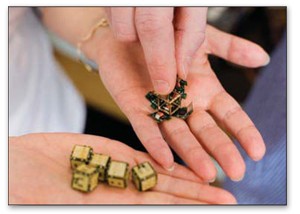Self-Sculpting "Smart Sand"

By Ashley Peterson
Robotic Self-Sculpting SandImagine what you could create with a bag of self-sculpting sand material that had the ability to morph on command, effectively transforming in shape within seconds.
Tiny self-assembling robots that can coordinate to form functional tools may sound like sci-fi fare, but this truth is stranger than fiction. According to researchers at MIT’s Distributed Robotics Laboratory, a “smart sand” product may be ready for market in as little as 10 years.
The work is being done by Danila Rus, a professor of computer science and engineering, and her student, Kyle Gilpin. According to Gilpin, the technology will allow the duplication of tools or mechanical parts almost instantly.
The Science Behind the Magic — How it Works:
To begin, the user places a scaled-down version of whatever they wish to create into a container of “Smart Sand” granules. The user then specifies the desired size. The individual grains transmit messages back and forth via an algorithm that senses the shape of the object and maps it in 3-D form, to the to-scale size. The grains not used for building simply fall away.
The technology could be used soon to reduce waste in our daily lives. The sand can create new parts; if a car rod shears, the broken part can be duct taped together, placed in the sand and used to form a new part. A major advantage of this type of material is that it is reusable and lends itself to producing things that aren’t necessarily needed forever. When an item has outlived its usefulness, it can be returned to the pile and reused to make something else.
Currently, the research team is working with 10-millimeter cubes (dubbed smart pebbles) to test out the algorithms behind the technology. They face the significant engineering challenge of scaling the technology down to sand grain size, and supplying each grain with sufficient computational power to run the algorithms.
Although there is still a lot more work to be done, Gilpin predicts that this “magic sandbox” could be on the market in as little as a decade. “In 10 years you might see a product on the market that starts to rival traditional manufacturing approaches. I think we might all be surprised at how quickly this advances once people really start looking at the technology.
Classroom Discussion
- Can you think of a time in your life when “Smart Sand” would have been useful?
- Do you think Gilpin’s 10-year launch target is too aggressive? What are some of the obstacles new technologies face?